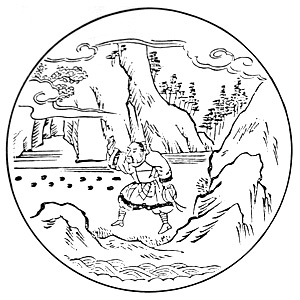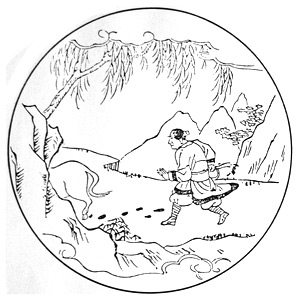ZEN IRODALOM ZEN LITERATURE
« Zen index
« Home
Ten Ox-Herding Pictures (심우도)
Woodcut prints by
unknown Korean artist
Seeking
the trace of original mind, buddhahood
by Chun Ock-bae
The Korea Times, 05-27-2010
http://www.koreatimes.co.kr/www/news/art/2010/05/135_66595.html
The Ten Ox-herding Pictures describe the path to enlightenment and self-development in the Seon tradition. You can see these pictures adorning the walls of Seon monasteries in China and Korea. These paintings depict a deep metaphor for Seon practice. Seon is a school of Buddhism that emphasizes the practice of meditation as the key to awakening one's true mind, Buddha-nature, and uncovering one's innate wisdom and compassion.
The pictures are the representation in folk images in Seon practices for training the mind. They depict a young ox-herder searching for and taming an ox. Its sequence represents a novice practitioner who comes to realize his own mind through Seon meditation. The pictures depict a young boy trying to find his lost ox. The young boy represents the practitioner and the ox represents the original mind the practitioner is trying to find. The paintings are divided into 10 stages of the meditation process while practicing Seon.
[Source of illustrations: 町元呑空 Machimoto Donkū's woodcuts in 改定評唱冠註十部録 Kaitei hyōshō kanchū jūburoku, Kyōto-shi: Baiyō Shoin, 1913]

1. Searching for the ox
In this first picture, the young ox-herder is in the wild looking a little lost, running around aimlessly. We are all like this ox herder in this world. We are anxiously looking for inner peace. The ox-herder is meditating for the first time in searching for his Buddhahood. In Seon Buddhism, it is considered that we all have the innate Buddha-nature, indicating the potential to manifest Buddhahood.

2. Seeing the tracks
The ox-herder finally sees some footprints. The boy, searching for the ox, finds its hoof-prints. Here the practitioner is catching a glimpse of his original mind or innate Buddhahood.

3. Seeing the ox
As the boy follows the tracks of the ox, he finally sees the ox half-hidden among the trees. This shows that if the practitioner studies and practices hard, he will find his true mind (Buddhahood). One week we visit a temple, another week we talk with a teacher. We continue to read books to find a good way to practice.

4. Catching the ox
The boy is trying hard to catch the wild ox with a rope. But the ox does not want to be caught. The boy has to hang on tightly as the ox jumps fiercely and drags him around.
Similarly, even though the practitioner has now had a glimpse of his true nature, he has not yet severed all delusions from his mind. It is a tough struggle to pacify all his wild thoughts.

5. Tending the ox
The boy is gently tending the ox and the ox is not wild any more. However, he is still holding on to the rope loosely because he knows that although the fight is over, he must remain vigilant. Even if one makes great progress, one must continue to practice hard.

6. Riding the ox back home
The ox-herder is sitting leisurely on the ox playing the flute. Riding the trained ox, the boy happily comes back home. If the practitioner controls his mind he will return to his true, original mind.

7. The ox forgotten, the ox-herder rests alone
The ox has disappeared and the ox-herder is resting at home. After the boy returns home he sits alone forgetting about the ox. He is at peace with his mind, body and heart. This means that even though the practitioner reaches a certain level of enlightenment, he should keep on practicing without rest.

8. Both the ox and ox-herder are forgotten
Now the ox-herder and the ox are both gone. There is only an empty circle. It represents "emptiness" attained by forgetting both ox and self. We all are interdependent. We are deeply connected to the world. We realize that everything comes out of emptiness.
Emptiness is not a vacuum, a black hole, but the possibility of endless transformation. We are a flow of conditions. We experience that we do not have a solid, separate identity. Through complete emptiness the boy attains a state of enlightenment.

9. Returning to original place
Now there is no ox and no boy, only the beautiful scene of the original, clear mind. Our life is ordinary and just as it is but we look at it differently.
With this mind it's possible to see things as they really are. "Mountains are mountains, and water is water." We realize that everything expresses the truth of life and awareness, and is talking to us.

10. Entering the marketplace with helping hands
The ox-herder, after years of practice, returns from the mountain to the village. We find spirituality everywhere; it is not confined to monasteries and secluded places.
This last stage represents freedom, wisdom and compassion, the core idea of Buddhism. The ox-herder goes to teach what he has realized to all the sentient beings.
Thus, we can see how practice deepens our realization at each stage as we continue on the path.
Through these pictures, the teaching of emptiness and interdependence telling us that things and people are not as solid as or as separate as we think they are. So we have to learn to see things as they really are. The famous Seon (Zen) master Dogen expressed this succinctly:
The way of
Buddha
is to know yourself,
To know yourself
is to forget yourself,
To forget yourself
is to be enlightened by all things.